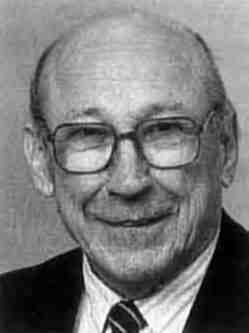


Obituary
Peder Kierkegaard (1928-1996)

Professor Peder Kierkegaard, Swedish crystallographer, died January 29, 1996. Kierkegaard spent his entire academic career at Stockholm University (PhD in 1955, DSc in 1962, appointed assistant professor of inorganic and physical chemistry in 1963, and first holder of a chair of structural chemistry in 1970). He retained the chair until his emeritus retirement in 1994.
X-ray crystallographic studies of alloys and inorganic compounds at the University began in the 1920's with the pioneering work of Arne Westgren with whom Kierkegaard spent his apprentice years. For his DSc thesis he chose transition metal oxide phosphates. Among his numerous papers in the field is the much quoted article on the structure of a sodium zirconium phosphate, known as the Nasicon structure.
Kierkegaard's scientific curiosity drove him to explore other fields of structural chemistry as well. Wi th coworkers, he undertook studies of metal complexes, organic molecules, glasses, and liquids. In research on equilibria in solutions, his diffraction studies were complemented with potentiometric measurements, and new apparatus was constructed for collecting accurate diffraction data for non-crystalline specimens.
In the late 60's Kierkegaard and his co-workers took part in an international collaboration involving systematic studies of a series of flavin derivatives, with the aim of providing detailed structural information on f1avoenzymes reactions. Research on compounds of pharmaceutical relevance was conducted in cooperation with Swedish industry. Other areas of study included structural characterization of sugar derivatives and investigations of host-guest complexes.
Kierkegaard was generous with ideas and advice and inspired his many students and coworkers with his enthusiasm for research. He acquired excellent research facilities and tirelessly fostered a collaborative atmosphere in the laboratory. Kierkegaard had exceptional organizational skills which he used in the service of the University at many posts including its board of directors. He was active in the Royal Swedish Academy of Sciences, to which he was elected member in 1982 and the National Committee for Crystallography. He was an organizer of many international conferences. Since 1987 he served as secretary to the Nobel Committee for Chemistry. The day before his death he was at his office at the Academy recording nomination letters for the 1996 Nobel Prize.
Kierkegaard was open and natural with everyone. He was a strong leader, who preferred to lead by cooperation. He loved to resolve problems at the daily morning coffee in the laboratory. He had an unusual talent for friendship and he will be missed and remembered by a vast number of friends and associates.
Arne Magnéli and Rolf Norrestam

